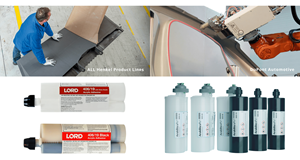JEC World 2016: Automotive highlights
On the automotive side, Henkel (Düsseldorf, Germany) emphasized on its JEC stand a glass fiber-reinforced composite leaf spring, based on Henkel’s polyurethane matrix resin Loctite MAX 2, used in the chassis of the new Volvo (Gothenberg, Sweden) XC90, a premium crossover SUV; the platform of this vehicle is expected to be applied to other Volvo cars in the coming years.
On the automotive side, Henkel AG & Co. KGaA (Düsseldorf, Germany) emphasized on its JEC stand a glass fiber-reinforced composite leaf spring, based on Henkel’s polyurethane matrix resin Loctite MAX 2, used in the chassis of the new Volvo (Gothenberg, Sweden) XC90, a premium crossover SUV; the platform of this vehicle is expected to be applied to other Volvo cars in the coming years. Frank Kerstan, global program manager, automotive composites, says BENTELER-SGL (Ried im Innkreis Austria) is making the leaf springs via resin transfer molding (RTM) in 30-second cycle times. Able to produce eight to 10 leaf springs in each mold, BENTELER-SGL plans to manufacture up to 500,000 leaf springs per year by 2018. On the developmental side, Kerstan says Henkel is working on several intriguing technologies, including a urethane-based adhesive for multi-material automotive bonding applications that have a CTE mismatch. Also in the works is an RTM-based molding system using urethane resin that allows for the fast production of Class A surface body panels. This is done, says Kerstan, by use of a double-injection process in which the second injection creates the high-quality part surface that Class A requires.
Meanwhile, at its JEC World stand, Huntsman Advanced Materials (The Woodlands, TX, US) announced that it has developed a new epoxy resin system and a novel, cost-efficient compression molding process, to facilitate the simple production of structural composite parts, and enable cycle times as low as 1 minute without any further post-curing for high-volume applications such as automo- tive. Currently, a trademarked ARALDITE is used to manufacture BMW’s (Munich, Germany) i-Series cars. With a cure time of 2 minutes at 130°C, this system gives a total cycle time of around 2,5 minutes. However, the latest rapid-cure ARALDITE epoxy system reportedly provides a cure time of only 30 seconds and displays a higher Tg, thus enabling robust processing up to 150°C and a press cycle time of only 1 minute, without further post-curing of the part. Following cure, the epoxy system displays a tensile elongation in excess of 5% with a Tg of 120°C.
To complement this new epoxy system, an innovative and simple Dynamic Fluid Compression Molding (DFCM) process also has been developed by Huntsman, which eliminates high-pressure injection and, in many cases, even the need for a preform. Resin impregnation occurs through the thickness, greatly reducing the potential for fiber displacement, a common problem with resin transfer molding (RTM). Company tests show reduced void content of laminates in comparison to conventional wet-compression molding (WCM) processing, and porosity of less than 1%, making it comparable to high-pressure RTM (HP-RTM) or autoclave, even in deep-draw parts. Fiber volume content of 66% can be easily achieved with no special processing conditions. The new DFCM process means lower mold pressures and a lighter press, plus no need for a high-pressure injection machine. Plus, DFCM eliminates resin waste because no surplus of resin or fiber is required to remove air from the part. The new process enables fast processing of thermoset parts, without the expense of prepreg and higher-priced thermoplastics.
Related Content
Pittsburgh engineers receive $259K DARPA award for mussel-inspired underwater adhesion
The proposed META GLUE takes inspiration from hydrogels, liquid crystal elastomers and mussels’ natural bioadhesives to develop highly architected synthetic systems.
Read MoreIPSA acquires bonding adhesives based on MMA technology
IPS Adhesives (IPSA) introduces a line of adhesives using acrylate and MMA technology from L&L Products for the bonding of dissimilar materials such as metals and composites.
Read MoreAdhesives, material solutions promote end market versatility
CAMX 2023: Rudolph Bros. and Co. highlights its role as a prominent specialty chemical distributor and solutions provider with a display of high-performance adhesives, sealants, materials and more from well-known manufacturers.
Read MoreHeat-activated foaming core rapidly achieves net-shape 3D parts
CAMX 2024: L&L Products exhibits its InsituCore foaming core structural technology, which can be used to create foam core composites minus machining or presses, as well as the Phaster A K-700, a rapid-cure adhesive.
Read MoreRead Next
Plant tour: Daher Shap’in TechCenter and composites production plant, Saint-Aignan-de-Grandlieu, France
Co-located R&D and production advance OOA thermosets, thermoplastics, welding, recycling and digital technologies for faster processing and certification of lighter, more sustainable composites.
Read MoreVIDEO: High-volume processing for fiberglass components
Cannon Ergos, a company specializing in high-ton presses and equipment for composites fabrication and plastics processing, displayed automotive and industrial components at CAMX 2024.
Read MoreAll-recycled, needle-punched nonwoven CFRP slashes carbon footprint of Formula 2 seat
Dallara and Tenowo collaborate to produce a race-ready Formula 2 seat using recycled carbon fiber, reducing CO2 emissions by 97.5% compared to virgin materials.
Read More



















